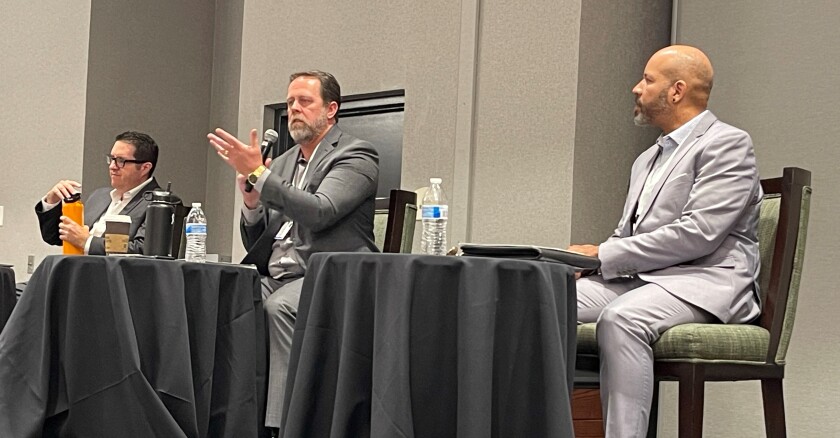Officials with the California Department of Social Services(CDSS) briefed vendors about the IT challenges that come with running the large agency and the many opportunities they see on the horizon.
The conversation — hosted by Industry Insider — California on April 18 in Sacramento — was a deep dive into the agency’s priorities and pain points as told by three high-ranking officials: Deputy Director and CIO Chad Crowe; Chief Technology Officer Mike Wanser; and Chief Information Security and Privacy Officer Gregory Nelson.
CDSS is a large agency with around 5,700 employees across 50 offices throughout the state, Crowe said. In its IT division, the agency has around 240 full-time employees. The overall DSS budget sits around $55 billion; for internal operations and IT, an exact number is harder to nail down, Crowe explained, though the figure is “in the billions as well.”
Enterprise Architecture Capability: Wanser said one of his current priorities is building out enterprise architecture capabilities and cloud data architecture — both are areas in which he welcomed vendor feedback. Crowe said this process is a big part of efforts to mature the IT operations. “Enterprise architecture, although not an emerging technology, is certainly very important to all of us. We really need to get a handle on the business and what’s going on … where the spend is, where the work is going, make sure that aligns with the strategy of the executive team,” he said.
Emerging Tech: While generative AI is grabbing a lot of attention across state government, Wanser said, education is a main priority there. Many are interested in deploying the new technology, but few of them understand the best use cases or ramifications.
For Nelson, generative AI could be especially useful in the security space when it comes to digesting log data, monitoring systems and reporting the data back to leadership.
One area of particular interest to Wanser is robotic process automation and the time it could save taking staff away from redundant processes. “We’ve got a lot of paperwork that needs to be filled out, a lot of manual processes. I’d love to figure out how to automate so … we can, you know, help [staff] focus on the analytical work rather than the day-to-day repetitive tasks.”
Low-code, no-code solutions are also being carefully examined.
Another focus, he noted, is moving to “soft phones” and away from the smartphones handed out to staff during the early days of the pandemic. Those devices are more difficult to secure than softphone options, Wanser said. Similarly, Crowe said there are challenges around agency growth and workspace. The agency grew by 45 percent in the last five years, but space to house staff hasn’t kept pace. Solutions and scheduling are being examined.
The Cloud: The agency has already made significant investment in cloud technologies, officials said, but there is still work to be done when it comes to consolidating and governing the data. “Right now, a lot of that data is spread throughout the organization. At the same time, we’re building up our data governance, and really working to kind of formalize and increase the maturity of our data,” Wanser said.
Big Projects: Several big projects are currently on the CDSS radar screen, Crowe said. California Supporting Providers and Reaching Kids (CalSPARK) came under the agency’s umbrella several years ago and brought with it five or six antiquated systems to manage child care and nutrition services.
The California Statewide Automated Welfare System (CalSAWS) eligibility verification has been underway for some time, but Crowe said significant progress has been made lately. “… We’ve gotten a lot of traction lately; there’s a lot of dedication to it. We’re now in stage two of that process,” Crowe said.
The Facility Management System (FMS) project is currently in the bid analysis stage. That project focuses on the licensing of care facilities for children, adults and seniors. An additional component of that effort — previously called Guardian, now called the Care Provider Management System (CPMS) — is focused on background checks for the staff working in these facilities.
The Housing and Homelessness Data Reporting Solution (HHDRS) is also a priority for the agency, Crowe said. “There’s been a big push to get reporting on housing and homelessness. So this is a system to grab up all the counties, all the data into a system and do reporting,” he said.
A summer EBT project called Sun Box is coming at the agency “hard and heavy,” Crowe said. That initiative centers on lunch program services during the summer months when students are not in school. A piecemeal solution is expected this summer, but Crowe said a more permanent solution will need to take its place afterward.
On the security side of the house, Nelson cited zero-trust architecture. Direction from the California Department of Technology (CDT) last year gave the agency a clear path forward and now some groundwork needs to be laid to implement. “What we’re looking to do, first and foremost, is to do an assessment that focuses in on our technology, and also focuses on our resources,” Nelson said. “... What we want is to have a road map for technology that tells us what technology we have in place that needs to be enhanced, and what technology do we need to add in order to have a zero-trust architecture in place that we can support.”
See Industry Insider — California’s previous coverage of Crowe hereand here and Wanser hereand here.
Social Services IT Leaders Talk ‘Audit Trauma,’ Turning a ‘Big Ship’
The California Department of Social Services has a very full plate, with several major IT projects at various stages.








